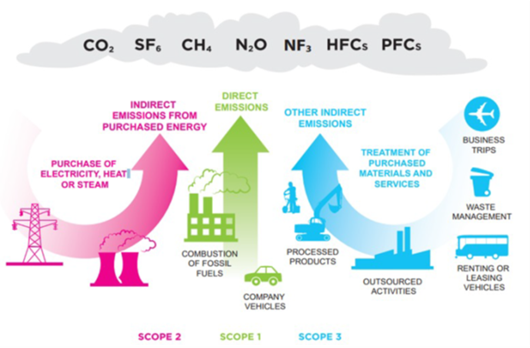Setting targets for Carbon Management Setting explicit targets for reducing carbon emissions helps to:
- Demonstrate leadership and commitment to our key stakeholders
- Focus and motivate across the organisation, among senior management and employees alike, to achieve real reductions in carbon emissions.
2 Types of target Two types of target are widely used:
Absolute targets:
- These are usually expressed as a reduction over time in a specified quantity of emissions to the atmosphere, the unit typically being tonnes of CO2 equivalents. Absolute targets are usually expressed as a percentage reduction from a baseline level of CO2 emissions, to be achieved over a set period of time.
Intensity targets:
- These are usually expressed as a reduction in the ratio of GHG emissions relative to another business metric for our organisation. The business metric could be a measure of the activity/output of the organisation (e.g. number of patients treated in a healthcare setting; number of students in an educational setting), or some other metric, e.g. office space. This would be stated in the form of tonnes CO2e per X (where X is the measure of the organisations activity/output). There are advantages and disadvantages of using the two different types of target. In particular, it should be borne in mind that relying on intensity targets alone can bring reputational risks. This is because meeting intensity targets may not result in a reduction in your absolute emissions, so you could be accused of failing to make a real contribution to tackling climate change. It is generally considered good practice for public sector organisations to set and publish absolute targets. Absolute targets are more directly consistent with the national targets and intentions set out in climate change legislation.
3 Target boundaries
In the private sector, we set reduction targets only for specific parts of the organisation. While there may be reasons for taking this approach there are reputational risks involved in doing this, since in such a scenario our total organisational emissions may go up even if targeted emissions go down. As a rule, the boundary that is set for our targets should be the same as the carbon footprint boundary set in your Carbon Management Plan, unless there is a very good exceptional reason why something within our footprint boundary should be excluded from our targets. If we consider setting targets for only certain parts of our organisation (and/or only for specific types of emissions), we must make sure that this is properly justified, made completely transparent and documented in our files and elsewhere as to what we are doing and why this needs to be the case for our organisation. In setting target boundaries, you also need to consider:
Which greenhouse gases?
Our target is always include CO2 emissions, plus any of the five other GHGs covered by the Kyoto Protocol2 for which our organisation has identifiable emissions. For many public sector organisations emissions of other GHGs may be likely to be minimal and difficult to identify/measure. For these reasons we need to conclude if it is appropriate to focus on our targets and measurement on our CO2 emissions only. We should always consider, document and make transparent what GHGs are and how they are included in targets, emissions measurement and reporting.
Geographical Operations
Having complex operations across multiple sites we start off by setting targets for only those sites where we have reliable emissions data. We will need to make assessments of what is reasonable and robust, given the estate and the operations of the organisation and the data available to us. An alternative to this approach would be to make informed estimations from the data which is available to us and by reference to benchmarks where necessary. Decisions will be made to exclude certain sites from targets an explicit statement of this and the rationale applied should always be recorded in our records/files with a commitment that, in the longer term, steps will be taken to cover all sites/operations in our targets and reporting.
Scope 1, 2 and/or 3 emissions?
As a minimum, we need to be setting targets based on Scope 1 and Scope 2 emissions. Setting targets for Scope 3 emissions is challenging; we need to bear in mind that we may not have much influence over many of your indirect emissions (e.g. in our supply chain). So, it makes sense to consider this carefully and only set targets for those types of emissions where we do have significant influence and where you can reliably measure the emissions. There is no point in setting a target for, or basing targets more widely on, elements which we cannot robustly nor comparatively measure performance against as you move forward.
Target Time Periods:
Short or Long Term?
As an organisation we need to set a target completion date which is a long time into the future, with a view to aligning to the national carbon emissions reduction targets enshrined in the Climate Change (Scotland) Act 2009 (i.e. for 2020 and 2050). Another reason to set a long term time can be to allow significant investments in new and more carbon-efficient buildings or equipment. A five year time frame is generally considered reasonable and practical for a public sector organisation.
Calculating Targets
The following is a recognised approach for making calculations to inform rational carbon reduction targets for your organisation.
Establish the emissions of your baseline year, our targets will typically be expressed as a percentage reduction against the baseline year. Establishing the baseline against which performance can be measured is fundamental for carbon management. The baseline will be the CO2e emissions of the organisation for a full year, typically the last full year for which you have the best information. As an organisation we should be satisfied that our baseline is as accurate and robust as reasonably possible.
Emissions source Estimated S4H emissions (tCO2e)
- Change between 2009/2019 and 2019-2022
- Baseline Year Scope 1 Emissions 15,000
- Baseline Year Scope 2 Emissions 16,500
- Baseline Year Scope 3 Emissions 18,150
- Reporting Year Scope 1 Emissions 16,500
- Reporting Year Scope 2 Emissions 18,150
- Reporting Year Scope 3 Emissions 19,965













